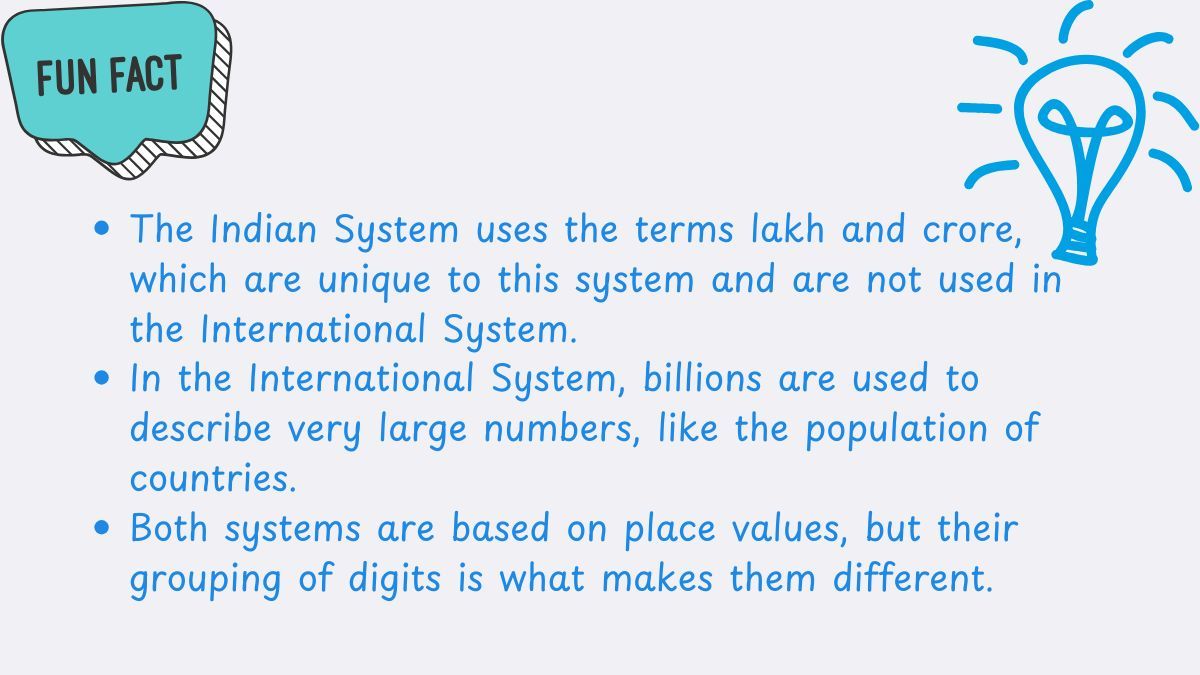Indian & International System of Numeration.
In this learning concept, the students will also learn to
-
Indian System of Numeration
-
International System of Numeration.
-
Key Differences Between the Two Systems
Each concept is explained to class 4 maths students using illustrations, examples, and mind maps. Students can assess their learning by solving the printable Indian System of Numeration & International System of Numerations grade 4 worksheets given at the page’s end.
Download the Indian System of Numeration & International System of Numerations worksheets for class 4 and check the Indian System of Numeration & International System of Numerations question for class 4 provided in PDF format.
Introduction
Numbers are everywhere around us! Whether we’re counting items, measuring distances, or handling money, numbers play a big role in our daily lives. But did you know that different countries use different systems to group numbers? The Indian System of Numeration and the International System of Numeration are two ways of grouping numbers that help us read and write big numbers easily. Let's explore these two systems and understand how they differ!
Indian System of Numeration
What is the Indian System of Numeration?
The Indian System of Numeration is used in India and some other countries in South Asia. This system groups numbers differently than the International System. In the Indian System, we start with ones, tens, hundreds, and then move to larger places like thousands, lakhs, and crores. In this system, numbers are grouped in places called "periods" and each period has three digits (except the first period).
The Place Value Chart (Indian System)
Here’s how the place value chart looks in the Indian System:
In this system:
1 lakh = 100,000
One lakh is written in the place value chart as given below:
10 lakh = 1000000
Ten lakh is written in the place value chart as given below:
Let us take a look at some examples
Example 1: 56,72,324
The number 56,72,324 is written in the place value chart as given below
Example 2: 8,94,35,87
The number 8,94,35,87 is written in the place value chart as given below
In the Indian System, we use commas differently: the first comma is placed after the three digits from the right, and then every two digits get a comma.
Example 3: Let’s say we have the number 7,56,89,432.
Here’s how to read it:
"Seven Crores, Fifty-Six Lakhs, Eighty-Nine Thousand, Four Hundred Thirty-Two."
International System of Numeration
What is the International System of Numeration?
The International System of Numeration is used by most countries worldwide, including the United States, the United Kingdom, and Canada. It uses different names for large numbers and groups them in thousands, millions, billions, etc.
The Place Value Chart (International System)
Here’s how the place value chart looks in the International System:
While writing numerals, we separate the periods using commas. While reading, we read digits in the same period together along with the name of the period.
We put a comma in 2363271 according to the International system as 2,363,271.
It is read as 'two million three hundred sixty-three thousand two hundred seventy-one.
Example 3: 1,234,567 (One million, two hundred thirty-four thousand, five hundred sixty-seven)
Example 4: 3,456,789,012 (Three billion, four hundred fifty-six million, seven hundred eighty-nine thousand, twelve)
In the International System, commas are placed every three digits from the right.
Key Differences Between the Two Systems
Why is Understanding Both Important?
In today’s world, we come across both types of systems. For example:
-
When reading the population of countries, you might see it in the International System (e.g., 1.4 billion).
-
But in India, we often hear numbers in lakhs and crores, like the value of properties or the population of cities.
By understanding both systems, you can easily read numbers in different contexts, whether it’s in your country or in international reports.

Fun Quiz on Indian & International System of Numeration
Choose the correct answer for each question. Good luck! 🎉
1. In the Indian System of Numeration, what comes after "thousand"?
A) Lakh
B) Million
C) Crore
D) Hundred
Answer: ______
2. How would you write "five lakh" in numbers?
A) 500,000
B) 50,000
C) 5,000
D) 5,000,000
Answer: ______
3. In the International System of Numeration, which place value comes after "million"?
A) Lakh
B) Billion
C) Crore
D) Thousand
Answer: ______
4. How would you write "three million" in numbers?
A) 3,000
B) 3,000,000
C) 30,000
D) 300,000
Answer: ______
5. In the Indian System of Numeration, how is the number 45,67,891 read?
A) Forty-five lakh sixty-seven thousand eight hundred ninety-one
B) Four million five hundred sixty-seven thousand eight hundred ninety-one
C) Forty-five thousand six hundred seventy-eight
D) Forty-five crore six thousand seven hundred eighty-one
Answer: ______
Practice Worksheets:
Click to download the worksheets for hands-on practice!
Easy Level Worksheets
Intermediate Level Worksheets
Advanced Level Worksheets

